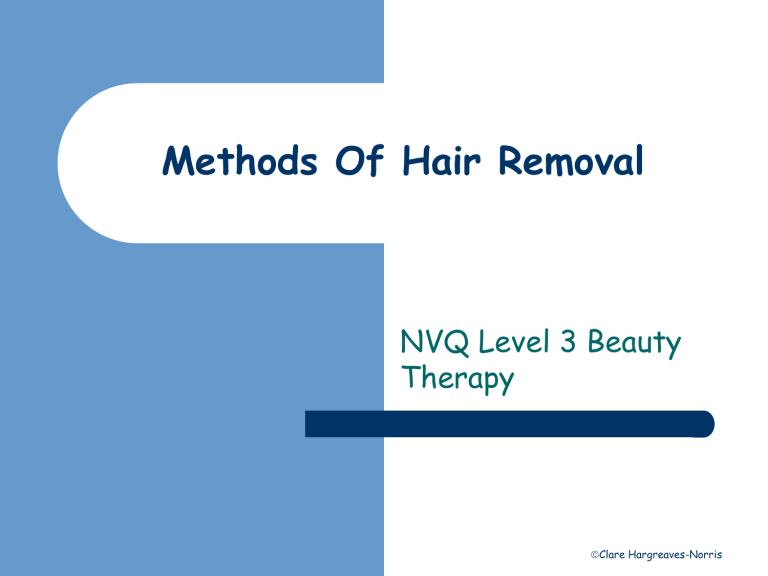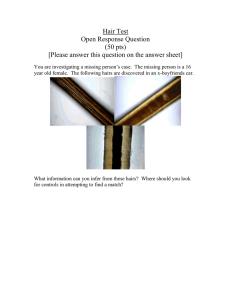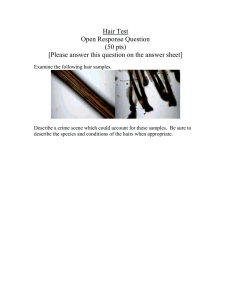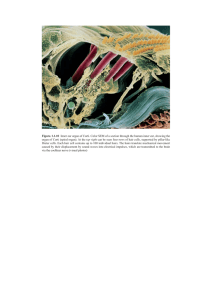
Methods Of Hair Removal NVQ Level 3 Beauty Therapy Clare Hargreaves-Norris Waxing and sugaring These products are designed to remove hairs at root level working against the direction of hair growth. They come in different formulations, each of which has their own specific benefits. Waxing/sugaring treatments are very effective at removing large areas of hair growth and are suitable for use on most areas of the body. Clients will be hair free for approximately 2-4 weeks. Waxing removes the hairs in the opposite direction of growth, which results in some hair follicle distortion. This should be taken into consideration when selecting a treatment as blend or galvanic currents are most effective at treating distorted follicles. Clare Hargreaves-Norris Shaving Shaving cuts the hair off at skin level; therefore the hairs will not be visible for the next few days. Shaving is only suitable for use on terminal hairs as it can topically stimulate further hair growth. Some experts believe that shaving an area a few days prior to an electrical epilation treatment is beneficial, as it will indicate to the electrologists, which hairs are in anagen stage. The longer hairs can then be treated resulting in a more effective treatment. Shaving and the products used can sensitise an area, therefore special considerations will need to be made if treating an area that is commonly shaved. Clare Hargreaves-Norris Depilatory creams Depilatory creams use chemicals to dissolve the keratin in the hairs to just below skin level and, as with shaving; the hairs will be visible within a few days. These products often have an offensive odour, which has been improved slightly over recent years. It is worth noting that the skin has a very similar composition to hair and therefore it is also affected by the chemical action of the cream. For this reason, these products can often cause an allergic reaction or sensitivity of the skin. Clare Hargreaves-Norris Depilatory creams continued Establish how long the client has been using the depilatory cream for and when the last treatment was. Discuss if any soreness, irritation or infection has occurred. If the treatment was recent, it may be necessary to wait until the skin has desensitised. Depilatory creams can also make the hairs brittle; this makes the hair difficult to release during the epilation treatment without causing breakage. Depilatory creams are not recommended for use on facial areas. Clare Hargreaves-Norris Tweezing and threading Tweezing/threading removes the hair at root level therefore; the hairs will not be visible again for 2-4 weeks. Tweezing is not recommended on facial areas except for the eyebrows or on large areas because it would be very time consuming. You should never tweeze hairs that are not terminal - this is because tweezing can stimulate topical hair growth, resulting in darker, coarser and more numerous hairs. If the client has been tweezing the area, look for any nips on the skin and make a note on the record card. The client may have been using incorrect technique when tweezing, removing hairs against the direction of growth and this would result in distorted follicles. In this instance, blend or galvanic currents are most effective. Clare Hargreaves-Norris Cutting Scissors can be used to trim the hairs to just above skin level. This is particularly useful for hairs growing from moles as no other method can be used. Hairs will obviously still be present but less obvious. The procedure will need to be repeated regularly and is not recommended for large areas. Cutting is the best method to manage hair growth inbetween electrical epilation treatments as it does not interfere with the treatment in any way. Clare Hargreaves-Norris Abrasives These can be an abrasive mitt or disk, and are rubbed over the skin using a circular motion until the hair is broken off, level with the skin surface. This method is really only useful on the legs, as other areas would be too sensitive and skin is often removed in the process. Abrasives are not recommended for use on facial areas. This is not a suitable method to use in-between epilation treatments as at makes it difficult to follow the line of the hair into the follicle. Clare Hargreaves-Norris Epilators These small, hand held machines electrically tweeze hairs from root level. Hairs will re-grow as with tweezing. It can be quite painful and a timeconsuming procedure and they cannot be used on hairs longer than a centimetre in length. Epilators are only suitable for use on the leg area, although some people use them on the underarms and bikini line. They should never be used on facial areas. This treatment can result in distorted follicles, sensitised skin and in-growing hairs, which will affect the epilation treatment. Clare Hargreaves-Norris Bleaching This is an effective way of lightening unwanted hairs by stripping them of colour. It is suitable for use on facial hairs and the forearms, however would be too costly and time consuming for use on larger areas. This is an effective way of disguising the appearance of unwanted hair growth in-between epilation treatments. However, it can make the hairs brittle and therefore liable to break off during removal. Bleached hairs are more difficult to see than darker hairs, so recommend that the client allow a little re-growth to make the insertions easier for the electrologist and allow the skin to desensitise. Clare Hargreaves-Norris Laser Laser hair removal is a non-invasive method that treats hundreds of hairs in a single treatment session. Large areas such as the back, shoulders, underarms, bikini line, arms and legs can be efficiently treated. Legally, laser manufacturers can claim permanent hair reduction but not (to date) removal. This method works because the laser light is converted into heat as it passes through the skin and is absorbed in the target pigment melanin found in the hair follicle. When the temperature reaches a high enough level in a hair follicle during its active phase, the hair structures are disabled, thus inhibiting hair regrowth. Clare Hargreaves-Norris Laser Although permanent hair removal is the aim of the treatment, some patients may experience hair regrowth that is usually finer and lighter in colour. In addition, long-lasting laser hair removal typically requires multiple treatments, which can make it a more costly hair removal alternative. Possible side effects, though very rare, may include damage to the surrounding healthy tissue in the form of scars, burns, redness and swelling. Special considerations are important when lasers are used on darker skin tones to allow for safe and effective treatment. Clare Hargreaves-Norris Tweezer epilation This method of electrical epilation is useful for treating a client who has a fear of needles. A much more powerful machine needs to be used as there is more opportunity for the current to be lost. A conductive gel is first applied and then each hair is gripped by the tweezers allowing the galvanic current to travel downwards, via the moisture film that surrounds the hair. As the connective tissue is also moist, the current can travel down to the dermal papilla where the chemical reaction starts to take place. The lye produced by the chemical reaction destroys the dermal papilla. However, treatment with this method takes much longer than with traditional methods of electrical epilation as it has a lower success rate. Clare Hargreaves-Norris



